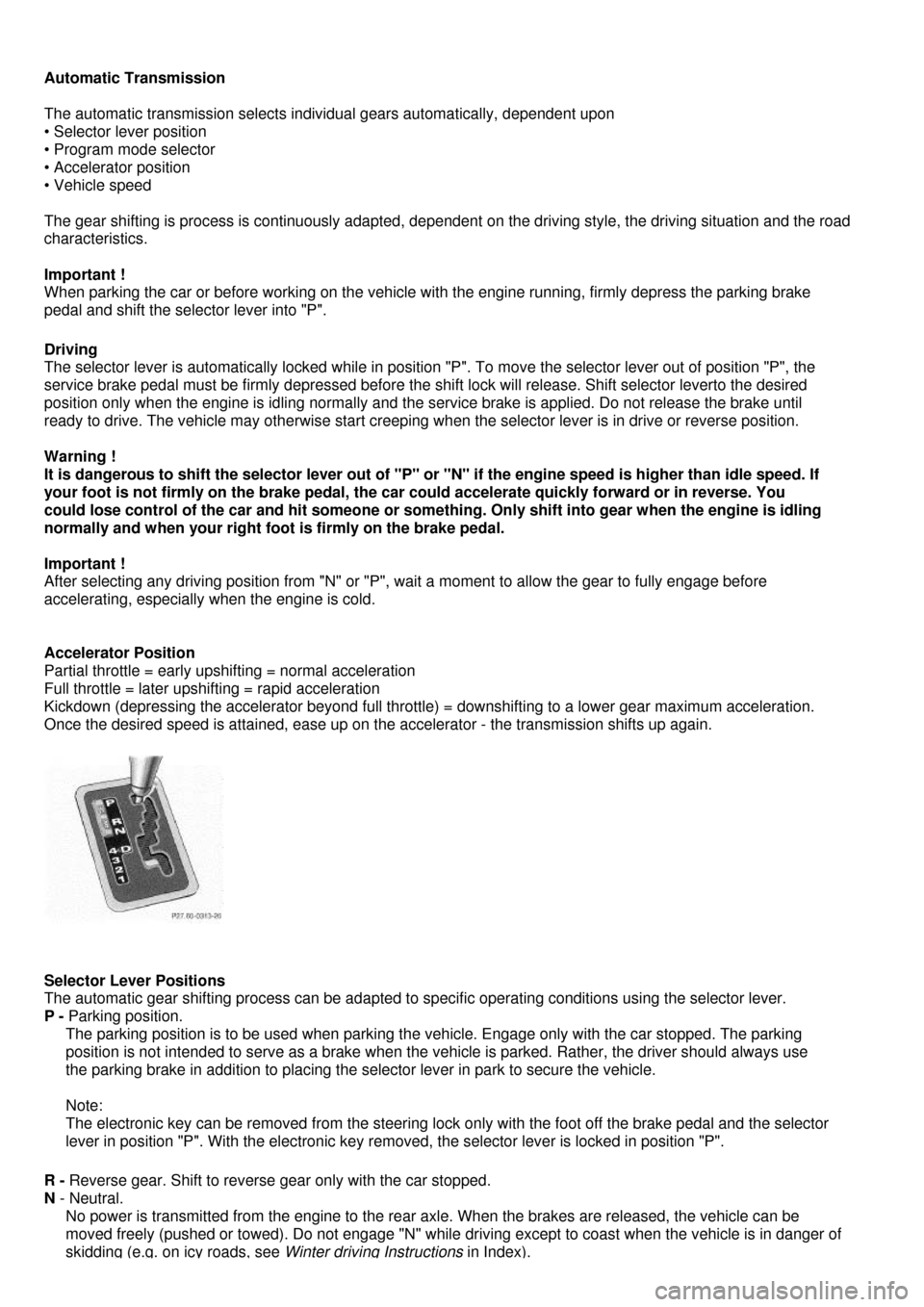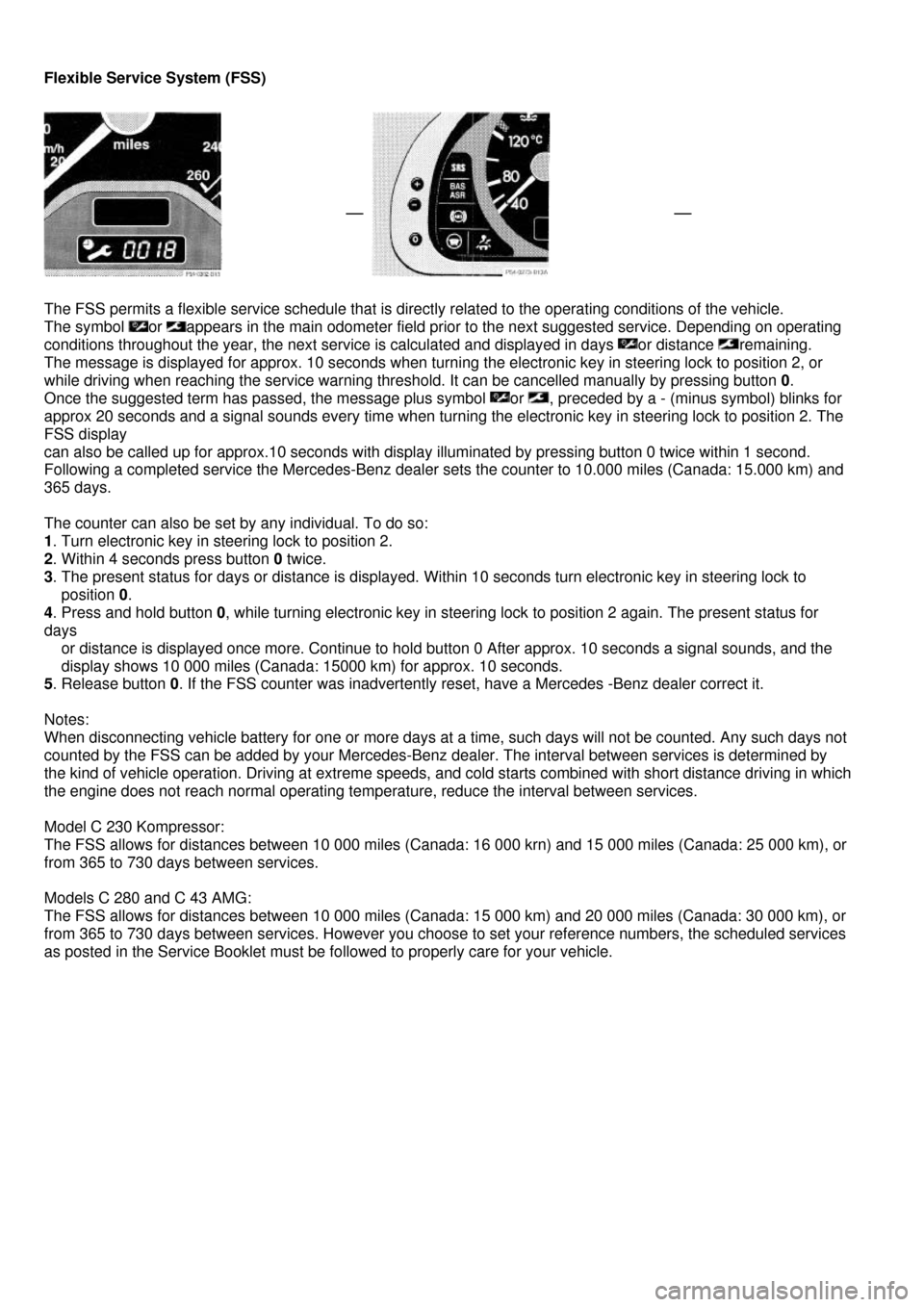service MERCEDES-BENZ C-Class 2000 W202 Owner's Manual
[x] Cancel search | Manufacturer: MERCEDES-BENZ, Model Year: 2000, Model line: C-Class, Model: MERCEDES-BENZ C-Class 2000 W202Pages: 130, PDF Size: 2.43 MB
Page 6 of 130

Catalytic Converter
Your Mercedes-Benz is equipped with monolithic type catalytic converters, an important element in
conjunction with the oxygen sensors to achieve substantial control of the pollutants in the exhaust
emissions. Keep your vehicl e in proper operating condition by following our recommended
maintenance instructions as outlined in your Service Booklet.
Caution!
To prevent damage to the catalytic converters, use on ly premium unleaded gasoline in this vehicle.
Any noticeable irregularities in engine operation shou ld be repaired promptly. Otherwise, excessive
unburned fuel may reach the catalytic converter causing it to overheat, which could start a fire.
Warning!
As with any vehicle, do not idle, park or operate this vehicle in areas where combustible
materials such as grass, hay or leaves can come into contact with the hot exhaust system,
as these materials could be ignited and cause a vehicle fire.
Page 8 of 130

Driving Instructions
Warning !
If you feel a sudden significant vibration or ride disturbance, or you suspect that possible damage
to your vehicle has occurred, you should turn on the hazard flashers, carefully slow down, and drive with
caution to an area which is a safe distance from the roadway.
Inspect the tires and under the vehicle for possible da mage. If the vehicle or tires appear unsafe, have
it towed to the nearest Mercedes-Benz or tire dealer for repairs.
Power Assistance
Warning !
When the engine is not running, the brake and steering systems are without power assistance.
Under these circumstances, a much greater effo rt is necessary to stop or steer the vehicle.
Brakes
Warning !
After driving in heavy rain for some time without applying the brakes or through water deep enough to
wet brake components, the first braking action may be somewhat reduced and increased pedal
pressure may be necessary. Be sure to maintain a safe distance from vehicles in front.
Resting your foot on the brake pedal will cause excessive and premature wear of the brake pads.
It can also result in the brakes overheating th ereby significantly reducing their effectiveness.
It may not be possible to stop the car in sufficient time to avoid an accident.
The condition of the parking brake system is checked each time the vehicle is in the shop for the required service .
If the parking brake is released and the brake warning lamp in the instrument cluster stays on, the brake fluid level in
the reservoir is too low. Brake pad wear or a leak in the system may be the reason for low brake fluid in the reservoir.
Have the brake system inspected at an aut horized Mercedes-Benz dealer immediately.
All checks and maintenance work on the brake system s hould be carried out by an authorized Mercedes-Benz dealer.
Install only brake pads and brake fluid recommended by Mercedes-Benz.
Warning !
If other than recommended brake pads are installed, or other than recommended brake fluid is used, the
braking properties of the vehicle can be degraded to an extent that safe braking is substantially impaired.
This could result in an accident.
Caution !
When driving down long and steep grades, relieve the load on the brakes by shifting into a lower gear. This helps prevent
overheating of the brakes and reduces brak e pad wear. After hard braking, it is advisable to drive on for some time, rather
than
immediately parking, so the air stream will cool down the brakes faster.
Page 19 of 130

Car Keys
Included with your vehicle are:
• 2 electronic main keys with integrated radio frequency and infrared
remote controls plus slide out and removable mechanical key.
• 1 electronic reserve key without remote control functions, plus
removable mechanical key.
Warning !
When leaving the vehicle always remove the electronic key from the steering lock, and
Lock your vehicle. Do not leave children unattended in the vehicle, or with access to an
unlocked vehicle. Unsupervised use of vehicle equipment may cause serious personal injury.
Electronic main key with integrated radio frequency and infrared remote control, plus
slide out and removable mechanical key. The remote control (1) operates all locks on the car.
The mechanical key (2) works only in the driver's door, trunk, and storage compartment locks.
The mechanical key (2) can be removed by sliding it out of the remote control. To do so, move
lock (3) in direction of arrow and slide the mechanical key (2) in direction of arrow (5).
In the case of using the mechanical key for lock operations, it can be extended outward. To do so,
move lock (3) in direction of arrow, slide the mechanical key (2) in direction of arrow (4) until it locks in
place. The remote control transmitter is located in the electronic main key. The infrared receivers are
located in the front door handles.
Note:
Remove the mechanical key from the electronic main key when using valet parking service. To prevent
access to trunk or storage compartments lock them separately.
Electronic reserve key without remote control functions,
plus removable mechanical key.
The electronic reserve key (1) works only in the steering lock.
The mechanical key (2) works only in the driver's door, trunk, and
storage compartment locks. To use the mechanical key (2),
remove it from its electronic reserve key (1).
Note:
We recommend that you carry the electronic reserve key plus mechanical key with you and keep it in a
safe place (e.g. your wallet) so that it is always handy. Never leave the electronic reserve key in the vehicle.
Obtaining Replacement Keys
Your vehicle is equipped with a theft deterrent locking system requiring a special key manufacturing process.
For security reasons, replacement keys can only be obtained from your authorized Mercedes-Benz dealer.
Page 44 of 130

Important !
The "SRS" airbags are designed to activate only in certain frontal (front airbags) impacts, or side (side
airbags) impacts. Only during these types of impacts, if of sufficient severity to meet the deployment
thresholds, will they provide their supplemental protection. The driver and passenger should always wear the
seat belts, otherwise it is not possible for the airbags to provide their intended supplemental protection. In
cases of other frontal impacts, angled impacts, roll-overs, other side impacts, rear collisions, or other
accidents without sufficient forces, the airbag will not be activated. The driver and passengers will then be
protected by the fastened seat belts. We caution you not to rely on the presence of an airbag in order to
avoid wearing your seat belt. The "SRS" is designed to re duce the potential of injury in certain frontal (front
airbags) impacts, and side (side impact airbags) impacts which may cause significant injuries, however, no
system available today can totally eliminate injuries and fatalities.
The activation of the "SRS" temporarily releases a small amount of dust from the airbags. This dust,
however, is neither injurious to your health, nor does it indicate a fire in the vehicle. The service life of the
airbags extends to the date indicated on the label located on the driverside door latch post. To provide
continued reliability after that date, they should be inspected by an authorized Mer cedes-Benz dealer at that
time and replaced when necessary.
Your vehicle was originally equippend with a Suppleme ntal Restraint system (SRS). The SRS airbags are
designet to activate in centrain impacts exceeding a preset treshold to reduce the potential and severity of
injury.merzedes-Benz encourages you to replace deploy ed airbags and repair any malfunktioning airbags to
ensure the vehicle will continue to provid e maximum crash protections for occupants.
Warning!
It is very important for your safety to always be in a properly seated position and to wear your seat belt.
For maximum protection in the event of a collision always be in normal seated position with your back
against
the backrest. Fasten your seat belt and ensure that it is properly positioned on the body. Since the airbag
inflates with considerable speed and force, a proper seating and hands on steering wheel position will help
to keep you in a safe distance from the airbag:
• Sit properly belted in an upright position with your back against the seat back.
• Adjust the driver seat as far as possible rearward , still permitting proper operation of vehicle controls.
• Do not lean with your head or chest close to the steering wheel or dashboard.
• Keep hands on the outside of steering wheel rim. Placing hands and arms inside the rim can increase the
risk and potential severity of hand/arm injury when the driver front airbag inflates.
• Adjust the front passenger seat rearward as far as possible from the dashboard when the seat is occupied.
• Children 12 years old and under must never ride in
the front seat, except in a Mercedes-Benz authorized BabySmart™ compatible child seat, which operates
with the BabySmart™ system installed in the vehicle to deactivate the passenger side front airbag when it
is properly installed. Otherwise they will be struck by the airbag when it inflates in a crash.
If this happens, serious or fatal injury will result . Failure to follow these instructions can result in severe
injuries to you or other occupants.
Safety Guidelines for the Seat Belt, Emergency Tensioning Retractor and Airbag
Warning !
• Damaged belts or belts that were highly stressed in an accident must be replaced and their anchoring
points must also be checked. Use only belts installed or supplied by an authorized Mercedes-Benz dealer.
• Do not pass belts over sharp edges.
• Do not make any modification that could change the effectiveness of the belts.
• The "SRS" is designed to function on a one-time-only b asis. An airbag or emergency tensioning retractor
(ETR) that was activated must be replaced.
• No modifications of any kind may be made to any components or wiring of the "SRS". This includes
the installation of additional trim material, ba dges etc. over the steering wheel hub, front passenger
airbag cover, or front door trim panels, and in stallation of additional electrical/electronic equipment on
or near "SRS" components and wiring. Keep area between airbags and occupants free of objects
( e.g. packages purses, umbrellas, etc.).
• An airbag system component within the steering wheel gets hot
after the airbag has inflated.
• Improper work on the system, including incorrect
installation and removal, can lead to possible injury
through an uncontrolled activation of the "SRS".
• In addition, through improper work there is the risk of rendering the "SRS" inoperative. Work on the
"SRS" must therefore only be performed by an authorized Mercedes-Benz dealer
• When scrapping the airbag unit or emergency tensioning retractor, it is mandatory to follow our safety
instructions. These instructions are av ailable at your authorized Merzedes-Benz
• Depending on the considerable deployment speed and the textile structure of the airbags, there is the
possibility of light skin abrasions.
Page 67 of 130

Drinking and Driving
Warning !
Drinking and driving can be a very dangerous combination. Even a small amount of alcohol or drugs can
affect your reflexes, perceptions and judgement. The possibility of a serious or even fatal accident is
sharply increased when you drink and drive. Please don't drink and drive or allow anyone to drive after
drinking.
Parking Brake
To engage, firmly depress parking brake pedal. When the electronic key is in steering lock position 2, the brake
warning lamp in the instrument cluster should come on brightly. To release the parking brake, pull handle on
instrument panel. The brake warning lamp in the instrument cluster should go out. A warning sounds, if you start
to drive without having released the parking brake. Also see Brake Warning Lamp Test in Index.
Driving Off
Apply the service brakes to test them briefly after driving off. Perform this procedure only when the road is clear
of other traffic. Warm up the engine smoothly. Do not place full load on the engine until the operating temperature has
been reached. When starting off on a slippery surface, do not allow one drive wheel to spin for an extended period
with the ASR or ESP switched off. Doing so may cause serious damage to the drive train which is not covered by
the Mercedes - Benz Limited Warranty.
Warning !
Keep driver's foot area clear at all times. Objects stored in this area may impair pedal movement.
Page 68 of 130

Automatic Transmission
The automatic transmission selects individual gears automatically, dependent upon
• Selector lever position
• Program mode selector
• Accelerator position
• Vehicle speed
The gear shifting is process is continuously adapted, dependent on the driving style, the driving situation and the road
characteristics.
Important !
When parking the car or before working on the vehicle with the engine running, firmly depress the parking brake
pedal and shift the selector lever into "P".
Driving
The selector lever is automatically locked while in position "P". To move the selector lever out of position "P", the
service brake pedal must be firmly depressed before the shift lock will release. Shift selector leverto the desired
position only when the engine is idling normally and the service brake is applied. Do not release the brake until
ready to drive. The vehicle may otherwise start creeping when the selector lever is in drive or reverse position.
Warning !
It is dangerous to shift the selector lever out of "P" or "N" if the engine speed is higher than idle speed. If
your foot is not firmly on the brake pedal, the car could accelerate quickly forward or in reverse. You
could lose control of the car and hit someone or something. Only shift into gear when the engine is idling
normally and when your right foot is firmly on the brake pedal.
Important !
After selecting any driving position from "N" or "P", wait a moment to allow the gear to fully engage before
accelerating, especially when the engine is cold.
Accelerator Position
Partial throttle = early upshifting = normal acceleration
Full throttle = later upshifting = rapid acceleration
Kickdown (depressing the accelerator beyond full throttle) = downshifting to a lower gear maximum acceleration.
Once the desired speed is attained, ease up on the accelerator - the transmission shifts up again.
Selector Lever Positions
The automatic gear shifting process can be adapted to specific operating conditions using the selector lever.
P - Parking position.
The parking position is to be used when parking the vehicle. Engage only with the car stopped. The parking
position is not intended to serve as a brake when the vehicle is parked. Rather, the driver should always use
the parking brake in addition to placing the selector lever in park to secure the vehicle.
Note:
The electronic key can be removed from the steering lock only with the foot off the brake pedal and the selector
lever in position "P". With the electronic key removed, the selector lever is locked in position "P".
R - Reverse gear. Shift to reverse gear only with the car stopped.
N - Neutral.
No power is transmitted from the engine to the rear axle. When the brakes are released, the vehicle can be
moved freely (pushed or towed). Do not engage "N" while driving except to coast when the vehicle is in danger of
skidding (e.g. on icy roads, see Winter driving Instructions in Index).
Page 69 of 130

Important !
Coasting the vehicle, or driving for any other reason with selector lever in "N" can result in transmission damage
that is not covered by the Mercedes-Benz Limited Warranty.
D - The transmission automatically upshifts through 5th gear. Position "D" provides optimum driving characteristics
under all normal operating conditions.
4 - Upshift through 4th gear only.
Suitable for performance driving. To shift from position "D" to "4", push selector lever to the left.
3 - Upshift through 3rd gear only.
Suitable for moderately steep hill s. Since the transmission does not shift hi gher than 3rd gear, this gear selection
will allow use of the engine's braking power downhill.
2 - Upshift through 2nd gear only.
For driving in mountainous regions or under extreme operating conditions. This gear selection will allow use of the
engine's braking power when descending steep grades.
1 - In this position, the engine's braking effect is utilized by shifting into 1st gear.
Use this position while descending very steep or l engthy downgrades and only at speeds below 40 mph (60
km/h).
Important !
With selector lever in position "D", "4" or "3", upshifting from 1st to 2nd to 3rd gear is delayed depending on vehicle
speed and engine temperature. This allows the catalytic converter to heat up more quickly to operating temperatures.
During the brief warm-up period this delayed upshift and increased engine noise might be perceived as a malfunction.
However, neither the engine nor transmission are negatively affected by this mode of operation.
The delayed upshift is effective with vehicle speeds below 31 mph (50 km/h) at partial throttle and engine
temperatures below 95°F (35°C). To avoid overrevving the engi ne when the selector lever is moved to a lower driving
range, the transmission will not shift to a lower gear, if the engine's speed limit would be exceeded. In this case there
will be no downshift, even when the vehicle speed reaches t he engine's speed limit of that gear, e.g. by applying the
service brakes. Continue driving in the usual manner. The transmission will then shift down automatically.
To prevent the engine from laboring at low RPM when driv ing uphill gradients or with your vehicle heavily loaded, the
automatic transmission will downshift when necessary to maintain engine RPM within the best torque range.
Warning!
On slippery road surfaces, never downshift in order to obtain braking action. This could result in drive wheel
slip and reduced vehicle control. Your vehicle's AB S will not prevent this type of loss of control.
Warning !
On slippery road surfaces, never downshift in order to obtain braking action. This could result in rear
wheel slip and reduced vehicle control. Your vehicle' s ABS will not prevent this type of loss of control.
Maneuvering
To maneuver in tight areas, e.g. when pulling into a parki ng space, control the vehicle speed by gradually releasing
the
brakes. Accelerate gently and never abruptly step on the ac celerator. To rock a vehicle out of soft ground (mud or
snow),
alternately shift from forward to revers e, while applying slight partial throttle. Rocking a vehicle free in this manner
may
cause the ABS malfunction indicator lamp to come on. Turn off and restart the engine to clear the malfunction
indication.
Stopping
For brief stops, e.g. at traffic lights, leave the transmission in gear and hold vehicle with the service brake. For longer
stops with the engine idling, shift into "N" or "P" and hold the vehicle with the service brake. When stopping the
vehicle
on an uphill gradient, do not hold it with the accelerator, use the brake. This avoids unnecessary transmission heat
build up.
Warning !
Getting out of your vehicle with the selector lever not fully engaged in position "P" is dangerous. Also,
when parked on an incline, position "P" alone may not prevent your vehicle from moving, possibly hitting
people or objects. Always set the parking brake in a ddition to shifting to position "P". When parked on
an incline, also turn front wheel against curb.
Page 72 of 130

Charge Indicator Lamp
Should the charge indicator lamp fail to come on prior to starting when the electronic key is in steering lock position 2
or should it fail to go out after starting or during operati on, this indicates a fault which must be repaired at an
authorized Mercedes-Benz dealer immediately.
If the charge indicator lamp comes on while the engine is ru nning, this may indicate that the poly-V-belt has broken.
Should this condition occur, the poly-V-bel t must be replaced before continuing to operate the vehicle. Otherwise, the
engine will overheat due to an inoperative water pump which may result in damage to the engine.
Do not continue to drive the vehicle with the charge indicator lamp illuminated. Doing so could result in serious engine
damage that is not covered by the Mercedes-Benz Limited Warranty.
Low Engine Oil Level Warning Lamp
With the electronic key in steering lock position 2, the o il level warning lamp comes on. It should go out immediately
when the engine is running.
If the warning lamp does not go out after starting the engi ne, or comes on with the engine running and at operating
temperature, the engine oil level has dropped to approximately the minimum mark on the dipstick.
When this occurs, the warning lamp will first come on intermittently and then stay on if the oil level drops further.
If no oil leaks are noted, continue to drive to the nearest service station where the engine oil should be topped to the
"full" mark on the dipstick with an approved oil.
The low engine oil level warning light should not be ignored. Extended driving with the light illuminated could result in
serious engine damage that is not covered by the Mercedes -Benz Limited Warranty. In addition to the warning lamp,
the engine oil level should be periodically checked with t he dipstick (or via the odometer display - Model C280 and
C43 AMG only), for example during a fuel stop, or before a long trip (see Engine Oil Level, Checking in Index)
Page 75 of 130

Low Engine Coolant Level Warning Lamp
With the electronic key in steering lock position 2, the warning lamp comes on.
It should go out when the engine is running. If the warning la mp does not go out after starting the engine, or if it
comes on while driving, then the coolant level has dropped below the required level. If no leaks are noticeable and
the engine temperature does not increase, continue to driv e to the nearest service station and have coolant added to
the coolant system (see Index).
The low engine coolant level warning light should not be ignored. Extended driving with the light illuminated may
cause serious engine damage not covered by the Mercedes-Benz Limited Warranty.
In cases of major or frequent minor coolant loss, have t he cooling system checked at your authorized Mercedes-Benz
dealer as soon as possible.
Note:
Do not drive without coolant in the cooling system. T he engine will overheat causing major engine damage. Monitor
the coolant temperature gauge while driving.
Warning !
Do not spill antifreeze on hot engine parts. Antifreeze contains ethylene glycol which may burn if it comes into contact
with hot engine parts. You can be seriously burned.
Low Windshield and Headlamp Washer System Fluid Level Warning Lamp
With the electronic key in steering lock position 2, the warning lamp comes on. It should go out when the engine is
running. If the warning lamp does not go out after starting the engine, or if it comes on while driving, the level of the
reservoir has dropped to approx.1/4 of the total volume. T he reservoir should be refilled with MB Windshield Washer
Concentrate "S" and water (or commercially available premixed windshield washer solvent/antifreeze, depending on
ambient temperature - see Index) at the next opportunity. The reservoir fo r the windshield and headlamp washer
systems is located in the engine compartment.
Page 77 of 130

Flexible Service System (FSS)
The FSS permits a flexible service schedule that is directly related to the operating conditions of the vehicle.
The symbol or appears in the main odometer field prior to the next suggested service. Depending on operating
conditions throughout the year, the next service is calculated and displayed in days or distance remaining.
The message is displayed for approx. 10 seconds when turning the electronic key in steering lock to position 2, or
while driving when reaching the service warning threshold. It can be cancelled manually by pressing button 0.
Once the suggested term has passed, the message plus symbol or , preceded by a - (minus symbol) blinks for
approx 20 seconds and a signal sounds every time when turning the electronic key in steering lock to position 2. The
FSS display
can also be called up for approx.10 seconds with display illuminated by pressing button 0 twice within 1 second.
Following a completed service the Mercedes-Benz dealer sets the counter to 10.000 miles (Canada: 15.000 km) and
365 days.
The counter can also be set by any individual. To do so:
1. Turn electronic key in steering lock to position 2.
2. Within 4 seconds press button 0 twice.
3. The present status for days or distance is displayed. Within 10 seconds turn electronic key in steering lock to
position 0.
4. Press and hold button 0, while turning electronic key in steering lock to position 2 again. The present status for
days
or distance is displayed once more. Continue to hold button 0 After approx. 10 seconds a signal sounds, and the
display shows 10 000 miles (Canada: 15000 km) for approx. 10 seconds.
5. Release button 0. If the FSS counter was inadvertently reset, have a Mercedes -Benz dealer correct it.
Notes:
When disconnecting vehicle battery for one or more days at a time, such days will not be counted. Any such days not
counted by the FSS can be added by your Mercedes-Benz dealer. The interval between services is determined by
the kind of vehicle operation. Driving at extreme speeds, and cold starts combined with short distance driving in which
the engine does not reach normal operating temperature, reduce the interval between services.
Model C 230 Kompressor:
The FSS allows for distances between 10 000 miles (Canada: 16 000 krn) and 15 000 miles (Canada: 25 000 km), or
from 365 to 730 days between services.
Models C 280 and C 43 AMG:
The FSS allows for distances between 10 000 miles (Canada: 15 000 km) and 20 000 miles (Canada: 30 000 km), or
from 365 to 730 days between services. However you choose to set your reference numbers, the scheduled services
as posted in the Service Booklet must be followed to properly care for your vehicle.